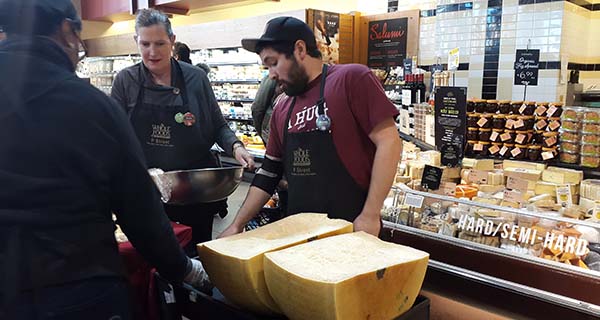
Whole Foods, the high-end US grocery chain known for its careful selection of specialty food, celebrated the production and “hand cracking” tradition of Parmigiano Reggiano in an initiative last Saturday aimed at educating consumers about the unique quality of a cheese still too often confused with generic parmesan.
The “Crack Heard Around the World” initiative saw certified cheese professionals in Whole Foods stores across the US manually “crack” wheels of 24-month old Parmigiano to be offered to guests for tasting, paired with red and white wines including Montepulciano d’Abruzzo and Pinot Grigio.
This is not the first time that Whole Foods teams up with the Consorzio Parmigiano Reggiano to support the unique and renowned cheese, but the timing of the promotion was particularly appropriate following the publication of a report by Bloomberg about an investigation by the US Food and Drug Administration (FDA) into the presence of poor quality substitutes and fillers such as wood pulp in US-made parmesan.
In a sign that educating consumers pays off, Protected Designation of Origin (Pdo) cheese is the third most popular Italian product in the US after wine and oil, with 179 million euros of exports in the first 11 months of 2015.
CATHY STRANGE: NUMEROUS DIFFERENCES WITH PARMESAN
“Parmigiano Reggiano’s taste and flavor is the best. The cheese production dates back 1000 years. The dedication of the farmers and the cheesemakers is incredible,” said Whole Foods global cheese buyer Cathy Strange, who also talks about the cheese in a video posted on the Whole Foods website
[youtube]https://www.youtube.com/watch?v=MaBX_sg8oQ4 [/youtube]
Asked about what unique features should consumers know, Strange listed many, starting from the oversight by the Consortium on the Protected Designation of Origin (Pdo) process, which keeps a commitment to history and quality in production. “The terroir reflects the best of Italy, the use of copper vats, the whey and the rennet, the use of evening skimmed milk combined with fresh morning milk and only two wheels per day per vat are important distinctive and unique differences,” Strange told Italianfood.net “Let me mention the flavor and taste again because this is a major point of the wonder of this cheese,” she said.
AGED AT LEAST 12 MONTHS – Other differences in other hard cheese products called Parmesan include age/maturation of at least 12 months (Whole Foods says it only selects 24-month old Parmigiano), time in brine, dedication of the cheesemakers, and feed of the animals. Moreover, while Parmesan can be produced everywhere, Parmigiano Reggiano is only made in the provinces of Emilia Romagna, and the rind has markings and a stamp of approval. One ounce of Parmigiano contains 121 calories, 11g of protein, and 311 mg of calcium, Whole Foods notes. Finally, a tip for American consumers: better to keep Parmigiano in the refrigerator, away from other foods, wrapped in a wax paper or in airtight container. And if a piece gets dry, you can still use it to add a tasty note to any dish.
By Antonella Ciancio
